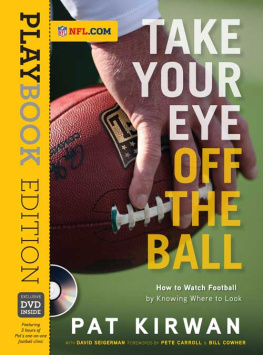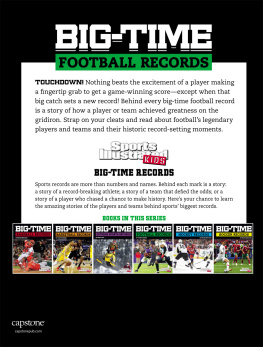
=Contents=
What Youve Been Missing All These Years
Uncharted Territory for Fans Looking to Follow the Action
Designing and Installing a Game Plan Is a Round-the-Clock Occupation
What a Quarterback Really Does
Running the Football in Todays NFL
Receivers Need to Be More Than Just Good Hands People
Why the Offensive Line Makes It All Happen
How Innovations Like the Wildcat Catch On
The Principal Differences between 3-4 and 4-3 Fronts
Pressuring and Protecting the Quarterback Is the Key to Success
How Defensive Backs Do Their Thing
Teaching the Game at the NFL Level
The Ideal Chain of Command in Todays Front Offices
Mastering the NFL Draft Can Make or Break a Franchise
A Glimpse into the Games Future
1
Show Off Your New Football Vocabulary
Foreword by Pete Carroll
I had just gotten to the New York Jets when I first met Pat Kirwan. It was around 1990, and he was still coaching at Hofstra University. From our very first conversation, I could tell he had an NFL-level understanding of football, and his perspective was so valuable that we immediately wanted to make him a part of the franchise.
Pat and I hit it off right away, and we wound up spending a lot of time talking about football concepts and philosophies. We didnt always agree on everything, but he had strong opinions that I always respected and an ability to analyze and evaluate players that was accurate and well founded.
When the salary cap was first instituted, I remember Pat and I sat down to read the rules together to determine what it was all about. We wanted to know it backward and forward to gain an advantage over everyone else. Pats a great competitor. When we were with the Jets, we used to play a lot of basketball together. He was the guy in the paint, Kippy Brown was our versatile player, and they both knew they had to feed me the ball (I only pass during football season). But you can learn a lot about people when you compete together, and Pat was always fun to battle with. Whatever shortcoming that left-hander had, he would will himself to win.
When I moved on to New England and then USC, Pat and I stayed connected, talking football and sharing ideas. He has always been an authority on whats going on in the league, someone whose understanding of players, coaches, situations, and trends has been an invaluable resource for me. Thats especially true when it comes to whats important in the makeup of a player. I remember when I was in New England, Pat mentioned Sean Morey to me during the 1999 NFL Draft. He was a receiver at Brown University who had set a bunch of Ivy League records. But Pat had really studied the kid and found that he was a fine all-around player, a tough guy, and a special competitor. He kept dogging me during the draft, and we finally took Sean in the seventh round. He made the Pats practice squad, and eventually he became a special teams captain, won a Super Bowl with Pittsburgh, then made the Pro Bowl as a special teams player in 2008. Now, hes with me again in Seattle. Sean probably never would have gotten drafted if Pat hadnt championed his cause. Pat was able to see the player for who he was and didnt hold his level of competition against him, and I trusted Pat enough to make the pick.
Pat and I have never really ended that football conversation we first started with the Jets. Were like football soul mates, people who just make sense to each other and have developed a level of non-verbal communication thats very special. Take Your Eye Off the Ball will give you a sense of what its like to watch the game of football through the eyes of a true expert.
Foreword by Bill Cowher
I have spent the last three seasons watching NFL games not from the sideline but from a television studio. As soon as we get off the air, my NFL Today colleaguesJames Brown, Dan Marino, Shannon Sharpe, Boomer Esiason, and Pat Kirwanand I head to the green room at CBS Studios in New York to watch every game of the afternoon.
Its great to hear the back and forth with those guys and to get their take on what theyre seeing. But as the only coach surrounded by a bunch of former players, theres no question that we just dont see things the same way.
Every time they see a bad play, Dan, Shannon, and Boomer blame it on a bad call by the coach. I then have to remind them that once in a while players do need to execute a play. Theyre wondering, What kind of call was that? and Im telling them that every play is good by design.
Theres a great respect that exists between everybody on the show, and we all do get along very well. But as you can imagine, the conversation can get pretty lively. And while Im defending coaches around the league, Pat is right there sitting next to me, shaking his head and laughing. He understands the dilemma Im in with these guys.
Officially, Pats an editorial contributor to the NFL Today . But the value of his football knowledge goes way beyond that.
That wont surprise any of you who know him from his show on Sirius NFL Radio or from reading his work on NFL.com. He has a truly unique perspective on the NFLhes coached in the league, hes worked on the management side of it, and he can talk to both players and owners. He has unbelievable insight into the big picture, into why certain things happenwhether its on the field or in the front office.
A lot of people know the game of football. Its a complex world we work in, and we all tend to overanalyze it and wind up making it even more complicated than it is. But Pat is able to articulate it all in such a clear way that anyone, any fan, can get it.
I hear him do this with his listeners all the time. They call in with questions about why their team doesnt make a change or do something differently, and Pat makes them think. Rather than encouraging them to have an emotional reaction, he teaches them to see everything thats going on and to look at the entire process.
Pat wants fans to have a better understanding of the game they love. He thinks that the more fans understand the game, the more they can appreciate how complex it is and why things happen the way they do. The more you learn, the more youll want to know.
And fans cant get enough of the NFL. Its 12 months a year of coverage now. Theres the season itself, followed by everything that goes into building a team in the off-season, and fans are intrigued by all of it. Pat is unique in that he can talk with authority about every aspect of todays NFL.
I think a book like this can be so helpful to fans, and Im flattered to be writing this foreword on behalf of someone for whom I have such great respect.
There are so many things to look at before the ball is snapped that will give you a better understanding of the gameif you know what to look for. This book will go a long way toward helping you understand what happens during the off-season, in the huddle before the snap, during the play itself, and in a teams draft war room. In short, it will teach you about all the complexities that make football Americas favorite sport.
Introduction
What Youve Been Missing All These Years
T o the untrained eye, football is chaosa collection of heavily armored men running in various directions and meeting in high-speed collisions all over the field. Every snap unleashes 22 players, each one with a specific assignment. It all happens so fast that most fans follow the game simply by following the ballfrom center to quarterback, then on to receiver or running back, and ultimately to the bottom of a pile. They see a handful of players doing their jobs, while everything else appears to be pure bedlam.
Next page










